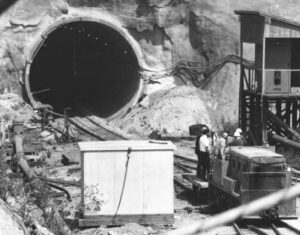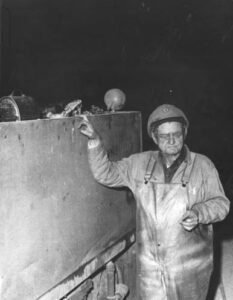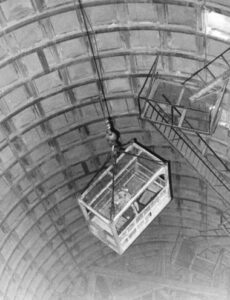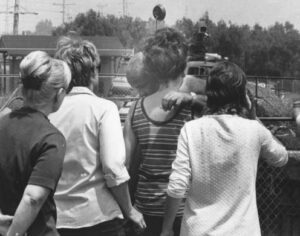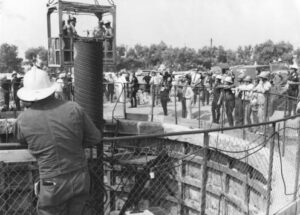Sylmar Water District Tunnel Explosion –
Methane Gas Vapor Intrusion
With 17 of its workers as casualties, the 1971 Sylmar Water District Tunnel Explosion became one of the most disastrous in California history. The explosion caused raging gases to come out of the tunnel. Fire Department Division Chief Robert Radke reported that everything in the tunnel was burning. The smoke was so thick “you couldn’t see your hand before your face”. The impact was similar to “a heavy dynamite explosion,” as described by Paul Badgley. He was a veteran in mines, who was away from the blast but was blown and stunned to his feet when it happened.
Badgley tried his best to rescue the men who were trapped in the tunnel. He tried to do so by driving to them using his motor. It became difficult for him because he couldn’t see clearly due to the extreme darkness. But six hundred feet from the end of the tunnel, he was able to find Louis Renteria. Whom was working on the gauge rail line at the time of the explosion. Because he still heard cries for help, Badgley proceeded to look for more people by furthering down the tunnel. Having very little oxygen in the area, Badgley needed to get a breath of air. But when he went back inside, he didn’t hear a sound anymore.
Negligence and Safety Violations
Ralph Brissette was found in the darkness 400 feet from the blast by two oxygen-deprived Lockheed workers who heard his cry for help. He was barely conscious when brought to Tacoma Lutheran Hospital. Brissette had been towards the back of the work area to load slag onto cars at the time of the explosion. He recently attended a memorial service for the 17 workers and the firefighters who tried their best to save them. Brissette described them as “the best of the best” during the commemoration.
This explosion proved the negligence and safety violations committed by the Lockheed Shipbuilding and Construction Co. Forcing them to face charges. The trial went on for so long that the resulting fines and damages became the most significant of its time. Reported by Los Angeles Times, the company was found “guilty of 16 counts of gross negligence and ten counts of violations of state industrial safety code.” They were fined more than $100,000 and were required to pay more than $8 million in civil judgments. To prevent this disaster from happening again, more strict mining and tunnel regulations have been imposed.
Cause of the Explosion
Did you know that the reason behind the explosion on Sylmar Water District Tunnel was Methane Gas? A few months earlier, an earthquake in the area was reported. This was believed to have created a passageway for underground gases such as methane, seeping through surfaces and accumulating. As we know, highly concentrated gas such as methane will inevitably explode, especially with an ignition source.
The day before the disastrous explosion happened, a flash fire at the entrance of the tunnel occurred. While Metropolitan Water District Inspector Louis L. Richardson and 17 other miners were boring a 5.5-mile water tunnel, suddenly there was an explosion. Smoke and dust suffocated some of them, while nine were sadly killed right away. One of those who were safe got treated, went back to work the next day, and died in the explosion.
Methane Gas Vapor Intrusion Mitigation Design and Construction
Like carbon monoxide, methane gas is also difficult to notice, and its presence will be evident once effects are seen. A buildup of carbon monoxide and methane gas in enclosures lead to oxygen deprivation. This may occur in areas such as a residential home or a tunnel. Worse is there is now a high chance the area will explode due to the high concentration level.
One of the causes of this accumulation is the migration of gases from a volume with high concentrations to low concentrations. This is called mass diffusion. To decrease the mass diffusion rate of methane, an extensive methane mitigation process was developed. It is now implemented to control methane gas hazards.
Methane Mitigation became necessary around the time of the Ross Store explosion. At the time, Methane Vapor Mitigation Engineers had to immediately develop a solution to prevent this kind of unexpected explosion from happening again. They thought of creating a methodology that utilizes a membrane application on the foundation to avoid methane seepage into the atmosphere. This membrane must already have decades of field data, so waterproofing products seemed like the best option. The reasoning behind this is that if waterproofing products prevent water seepage, they can also prevent or decrease methane migration.
Waterproofing Membranes as a Methane Barrier
To ensure that these products would work as a sealant, a licensed LADBS Testing Agency tested pre-existing Waterproofing Membranes as a methane barrier. This hypothesis was then proven because waterproofing products such as spray-applied asphalt emulsions aided in slowing down the mass diffusion rate of methane. With this data, methane barrier specifications were developed to ensure reliability in slowing down methane’s mass diffusion rate. Aside from methane barriers, a methane gas vapor intrusion system is composed of other essential elements defined by the LADBS Methane Mitigation Standard Plans, which need to be implemented in the Methane Gas Vapor intrusion system by a Vapor or Methane Mitigation Contractor.
These essential elements are methane alarms and methane sensors and lowest level methane ventilation fans in areas with high-risk methane gas intrusion. Methane Alarms and Methane Sensors continuously monitor methane concentrations and get triggered to notify occupants of the possible Methane Hazard. These alarms and sensors will be installed in the lowest space of the building.
The sub-slab vent system decreases the mass diffusion rate of methane gas by forcing the methane gas to flow through the vents instead of through the building. To do this, exhaust fans and blowers, a perforated pipe, and a gravel blanket are utilized. Having a sub-slab vent system will prevent the accumulation of methane gas into the structure, lowering the concentration, ultimately decreasing the mass diffusion rate of methane. Another purpose of sub-slab vent system installation is to provide relief in the case of an obstruction on the membrane.
Such a critical system must be designed by someone who has experience designing methane depressurization vent systems. A licensed professional engineer and a gas vapor mitigation contractor must be consulted to ensure the accuracy and reliability of the sub-slab vent system and the entire methane mitigation system.

